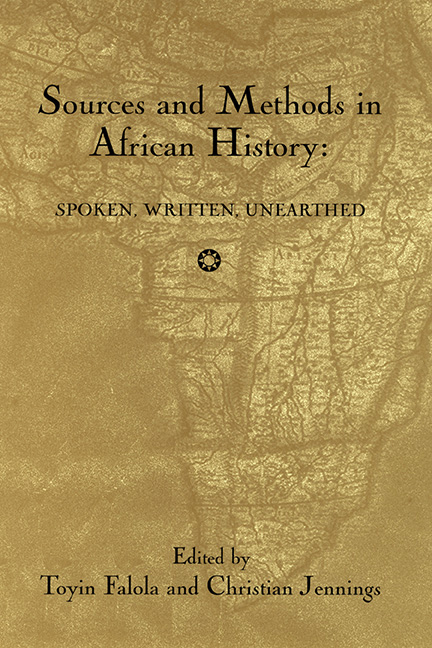Book contents
- Frontmatter
- Dedication
- Contents
- Acknowledgments
- Introduction
- Part I Archaeological Sources
- Part II Africa and the Atlantic World
- Part III Documentary Sources
- Part IV Oral Tradition
- Part V Innovative Sources and Methods
- 19 Section Introduction: Innovative Sources and Methods
- 20 Ben and Maggie: Consuming Data: Reassessing Scientific and Anthropological Evidence: Historical Perspective on Nutrition Studies
- 21 Electricity Networks in Africa: A Comparative Study, or How to Write Social History from Economic Sources
- 22 “Rain or Shine We Gonna' Rock”: Dance Subcultures and Identity Construction in Accra, Ghana
- 23 Sample Surveys: Underexploited Sources for African Social History
- Contributors
- Index
21 - Electricity Networks in Africa: A Comparative Study, or How to Write Social History from Economic Sources
from Part V - Innovative Sources and Methods
Published online by Cambridge University Press: 25 October 2017
- Frontmatter
- Dedication
- Contents
- Acknowledgments
- Introduction
- Part I Archaeological Sources
- Part II Africa and the Atlantic World
- Part III Documentary Sources
- Part IV Oral Tradition
- Part V Innovative Sources and Methods
- 19 Section Introduction: Innovative Sources and Methods
- 20 Ben and Maggie: Consuming Data: Reassessing Scientific and Anthropological Evidence: Historical Perspective on Nutrition Studies
- 21 Electricity Networks in Africa: A Comparative Study, or How to Write Social History from Economic Sources
- 22 “Rain or Shine We Gonna' Rock”: Dance Subcultures and Identity Construction in Accra, Ghana
- 23 Sample Surveys: Underexploited Sources for African Social History
- Contributors
- Index
Summary
Electricity in Africa has been very little studied. Bibliographical material is nearly nonexistent. Works that treat the history of urban electricity are rare. There is one good recent study on electricity in South Africa (Christie 1984), and a shorter one on West Africa (Sarfoh 1990). As for the rest of Africa, one finds occasional analyses of electricity in the countryside of underdeveloped countries issued by the World Bank (1975) or, very recently, by AFREPEN (African Energy Policy Research Network, 1999), in particular on Central and Eastern Africa. There is not much, and everything is in English. As for works in French, one finds a slim prewar survey (François 1937), and several unpublished master's theses, either finished or in progress (Ardurat 1999, Saupique 2000, Stéphanie Robert 2001) under the aegis of the Association pour l'Histoire de l'Electricité en France; more rarely there are brief allusions to the existence of some published or unpublished dissertations (Seck 1970, Danfakha 1990). Everything else has yet to be done, since the documentation is not lacking; it can be gleaned from the depths of varied and very complete archives—notably the series “Travaux Publics” and, after the war, those of FIDES (Fonds d'Investissement et de Développement Économique et Sociale) and of FAC (Fonds d'Aide et de Développement)—and in numerous technical reviews of the period, colonial or otherwise.
This work should absolutely be undertaken, as the study of electricity in the colonies opens multiple avenues of research. Obviously it is, essentially, an area of economic history that is still quasi-virgin. It includes the history of production of large metropolitan companies in this area, and the role that they have played in the equipment: mining production and improvement of the rail network (especially in South Africa), etc. But the implications go far beyond that; an example is a brief visionary study in urban history about public lighting in Tunis (Belaid forthcoming), and several reports of the history of dock workers in Durban after electricity was brought to the port (Atkins 1993); one could go much farther in social history, asking about the incidence of electricity in everyday life and the changes of mentality, something that seems not to have been attempted overseas.
- Type
- Chapter
- Information
- Sources and Methods in African HistorySpoken Written Unearthed, pp. 346 - 360Publisher: Boydell & BrewerPrint publication year: 2003

